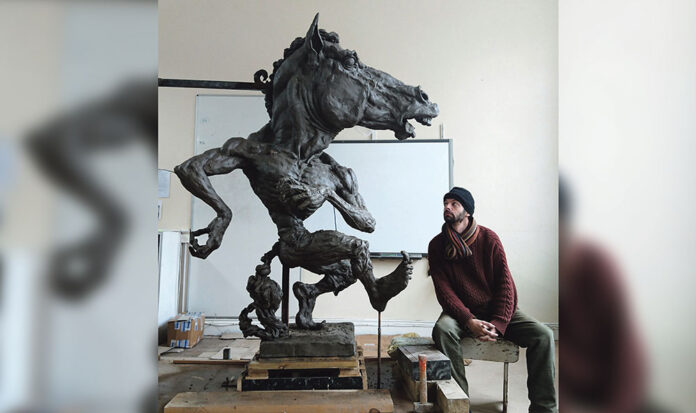THE artist involved in a controversial public sculpture commission for Ennistymon has insisted there is nothing malevolent about his proposed Púca, and that it has real potential to attract and engage visitors, writes Fiona McGarry.
Aidan Harte told The Champion that despite the Council’s decision to pause the project in response to public objections, he is hopeful that people will come to appreciate the design of the 2m high artwork.
Mr Harte, who has studied sculpture in Florence in Italy, has told Clare County Council he is fully prepared to visit Ennistymon to engage with local people.
“We can’t railroad or ignore people’s views,” he said. “This piece certainly isn’t disrespectful. Art is a matter of taste and I can understand that people don’t want art they don’t like, but this is an impressive piece when you see it in the flesh.
“I think people will come to appreciate the craft that is involved. I’m more than willing to come to Ennistymon to meet and chat with people.
Half-horse and half-man, the piece has been crafted in clay, but won’t be cast in bronze for the moment.
“Part of the brief was to create something to attract people to Ennistymon,” Mr Harte observed. “It’s a lovely town, but people tend to drive through to Lahinch and the Cliffs of Moher and the brief was to create something out-of-the-ordinary to draw people to visit it.
Thanks, Dara! This horse isn't out of the race yet. Lots of Púca love coming from Clare right now.
— Aidan Harte (@HarteAidan) May 12, 2021
“If you think about Copenhagen’s Little Mermaid or David in Florence, public sculptures have the power to put a place on the map for tourists.”
The proposed artwork was commissioned as part of a significant investment in the Ennistymon streetscape by Fáilte Ireland and Clare County Council.
The design came in for some intense criticism on social media, and is the subject of a petition signed by over 50 people.
The Kilkenny native was philosophical about the row, which included a denunciation from Fr Willie Cummins, Parish Priest of Ennistymon.
“These things happen, the history of public art is full of controversies,” Mr Harte said.
“It’s odd that it has happened on the basis of a picture that a lot of people will only have seen on their phones. In the flesh, the piece has great personality.
“The fact that it has already attracted such publicity shows that is something that’s out-of-the-ordinary and that people will respond to it.
“If you think about it, it’s not often you have people engaged in such a vigorous debate about art.”
Mr Harte rejected suggestions that the Púca is a sinister character or that it could bring a negative energy to the town.
“The concern that he is pagan is way off the mark in my view,” he said. “He’s no more pagan than a leprechaun. He’s a surreal character with an air of fantasy and mystery.
“I think some people have gotten the wrong end of the stick. There’s nothing malevolent about him. He’s inspired by folklore and mythology and I believe people will really engage with him. The idea of the raised foot is that people can rub his toe and make a wish.
“While I’ve been working on him in my studio, I’ve had parents bring their kids in and they loved him. Ironically, I’ve also had two priests visit and so did they.
“I suppose the main thing is that a piece of public art should make its own case.
“There are lots of very unexciting, uncontroversial sculptures out there. This isn’t bland and generic and I think it has the potential to be a big tourist attraction.”
In a statement, Clare County Council said it will now undertake “a broader public engagement” on the sculpture.
It said it has paused the project “in light of the questions and concerns that had been raised about the artwork”.
A native of Ennis, Colin McGann has been editor of The Clare Champion since August 2020. Former editor of The Clare People, he is a journalism and communications graduate of Dublin Institute of Technology.


